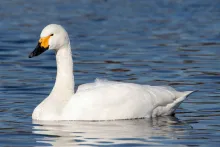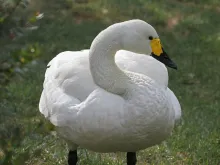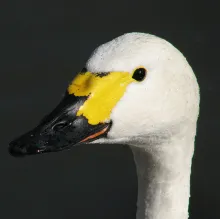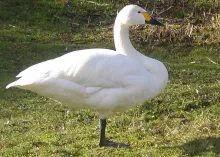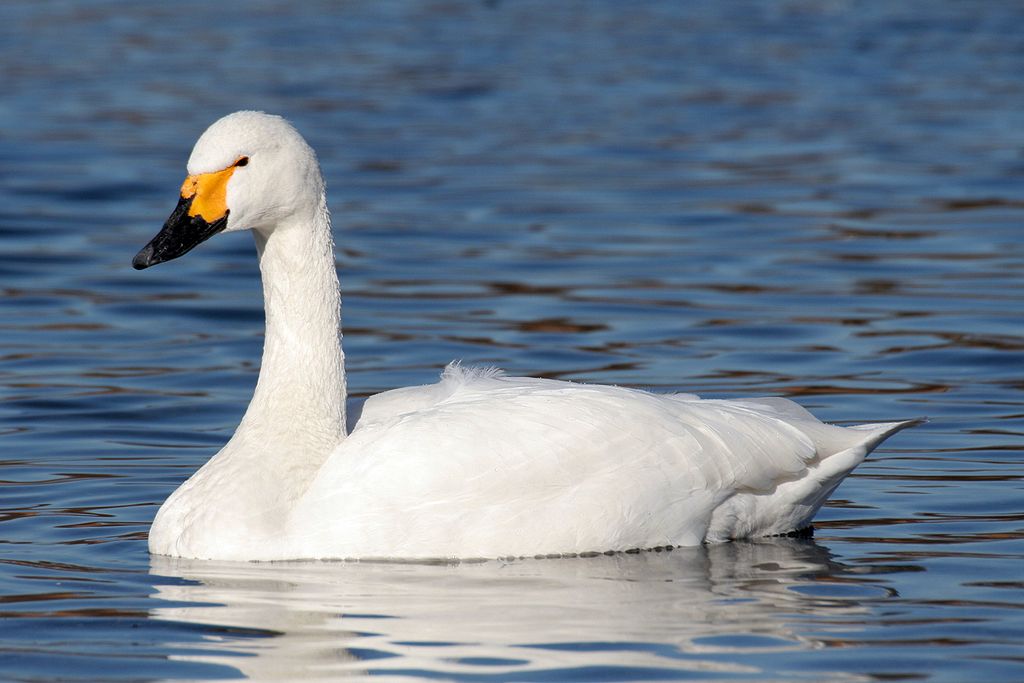
Bewick's swan (Cygnus columbianus bewickii)
Species name
- Dutch name:
- Kleine zwaan
- English name:
- Bewick's swan
- German name:
- Zwergschwan
- French name:
- Cygne de Bewick
- Scientific name:
- Cygnus columbianus bewickii
Scientific classification
- Order:
- Anseriformes
- Family:
- Anatidae
- Onderfamilie:
- Anserinae
- Genus:
- Cygnus
Description
- Description:
Male:
The male is completely white, though their heads and necks are often stained a rusty color from ferrous minerals encountered in marsh soils during feeding. The bill is black and often has a Dark yellow at the base long the edges of the bill with black going up the center of the bill to the feather line. The legs and feet are black and the iris is dark brown. (C.c. bewickii)- has less yellow on bill more almost like a complete circle on both sides. (C. c. jankowskii) is slightly a larger bird by 10%, has more yellow on bill and appears to have a blue iris.Female:
The female is identical in appearance, but males typically are larger.Juvenile:
Grey-Brown, darker on the head and neck, paler on underparts. Gradually becomes whiter during first year, though a few scattered grey-brown feathers on head and rump retained well into second year. This gets full adult plumage by the end of second winter. Bill pink at base, brown towards tip, pink slowly changing to yellow after first year.
- Behaviour:
The young swans, known as cygnets, will have fully fledged after a further 40-45 days . They stay with their parents during the first winter and often during their second too, even if the parents have produced a new brood.
Standard Measurements
- Body Length (cm):
- The male (drake) of the Bewick's swan measures approximately 118-135 centimeters. The female measures approximately 118-135 centimeters.
- Body Weight (grams):
- The male will weight about 6200 gram. The female will weight about 5500 gram.
The weight is notoriously variable and can only be used as indication!
- Subspecies:
There are two subspecies:
- Cygnus columbianus bewickii, Bewick's swan
- Cygnus columbianus columbianus, Whistling swan
- Habitat:
The little swan needs water and grassland. A pond with an area of 12-15 m2 or larger and a depth of one and a half meters is desirable in aviculture. The depth of the pond is important for mating. Furthermore, scarce low vegetation near the pond is possible. Banks should be at a shallow angle to allow easy entry to and exit from the water; this is particularly important if cygnets are to be parent reared. More than one pair may be kept in very large parks where each pair can establish a breeding territory. Swans appreciate water weed and grass, but other green foods such as lettuce and cabbage may be used as substitutes if necessary. They are relatively slow eaters and care should be taken in mixed enclosures that they get sufficient food. Good amounts of vegetation should be provided for nest building, with cover available for early-nesting species. Parent hatching and rearing is usual. Swans are able to defend their young against most predators, and their highly-aquatic lifestyle also makes cygnets less vulnerable. Unlimited green food should be available for the cygnets.
- Note:
The little swan needs water and grassland. A pond with an area of 12-15 m2 or larger and a depth of one and a half meters is desirable in aviculture. The depth of the pond is important for mating. Furthermore, scarce low vegetation near the pond is possible. Banks should be at a shallow angle to allow easy entry to and exit from the water; this is particularly important if cygnets are to be parent reared. More than one pair may be kept in very large parks where each pair can establish a breeding territory. Swans appreciate water weed and grass, but other green foods such as lettuce and cabbage may be used as substitutes if necessary.
They are relatively slow eaters and care should be taken in mixed enclosures that they get sufficient food. Good amounts of vegetation should be provided for nest building, with cover available for early-nesting species. Parent hatching and rearing is usual. Swans are able to defend their young against most predators, and their highly-aquatic lifestyle also makes cygnets less vulnerable. Unlimited green food should be available for the cygnets. The female can breed from the age of three or four. The nest is built near the water in a dry elevated place. The nest usually consists of grass stems, twigs, foliage and preferably mosses. The laying takes place around May-June. The female hatches the eggs and the male guards his family with full conviction.
- Breeding:
- The female Bewick's swan usually lays from 3-6 creamy white eggs and incubates them for 29-30 days.
- Artificial incubating:
The ideal relative humidity for incubating most waterfowl eggs is 55% (ground nesters) and 40% (cavity nesters). The temperature is usually 37.4°C. Set ventilation as recommended by the incubator manufacturer. Eggs must be turned, either automatically or by hand, a minimum of 4 times a day. As the duckling develops there is a loss of water from the egg and the air sac gets bigger. In normal development of an egg with a 29-30 days incubation, the air sac occupies about a third of it three days earlier. Cleanliness is vital and ideally eggs should be moved to a separate hatcher at this point, where the humidity should be increased to 65% and even higher once they have pipped internally.
- Recommended closed leg band ring size for the Bewick's swan is 24 mm.The leg band ring can only be applied on a young swan at around days old.
- It doesn't matter what leg that you band, but it's good to have a consistent system. Suggested: Left leg = Female, Right leg = Male
- Rearingfeed:
-
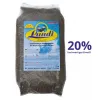
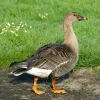

Floatable special rearing feed for all types of aquatic ornamental fowl - especially for the cultivation of trees as well as greening ducks.
This well-balanced complete feed with 20% protein content convinces above all by its good compatibility and forms the basis for visibly healthy growth from day one.
Made exclusively from wholesome and selected raw materials, Lundi Micro Regular is also ideally suited for the year-round feeding of waterfowl.
- Maintenance food:
-



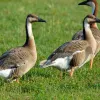

Lundi Regular with a protein content of 20%, valuable Spirulina and high-quality by-products is optimally balanced in its composition maintenance food for water ornamental fowl of all kinds. Especially green teal and Whistling ducks that are not dependent on a very high protein content, are well supplied.
Lundi Regular contains all the minerals and vitamins in full form that are important for the animals. Therefore also suitable as breeding food.


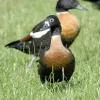


Floating full food for all sea ducks, green ducks, eider ducks and geese, especially in the moulting and breeding phase ideally suited. Packed with wholesome raw materials, natural vitamins and trace elements, this performance food with a protein content of 30% forms the basis for lifelong vitality.
- Regulation:
- Europese soort
- Regulation:
Receives general protection in Great Britain under Schedule 1 of the Wildlife and Countryside Act and listed under Annex I of the EC Birds Directive. Classified as a Species of European Conservation Concern.
